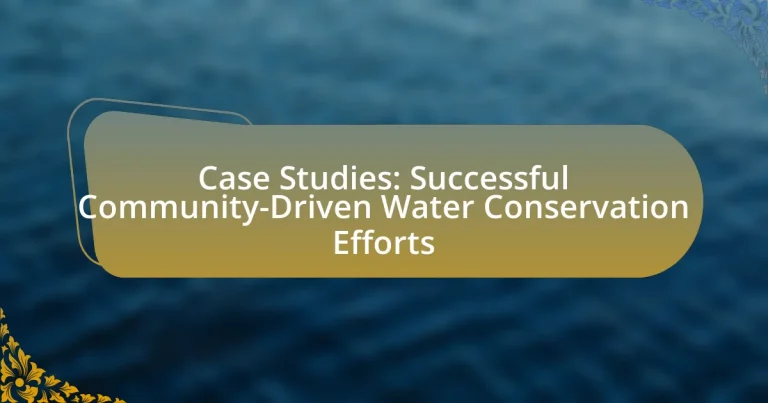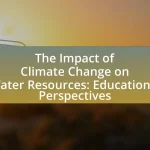Community-driven water conservation efforts are initiatives led by local populations to sustainably manage and protect water resources through collaboration among residents, organizations, and government entities. This article explores various successful case studies, such as those in Tigray, Ethiopia, and Rajasthan, India, highlighting the effectiveness of grassroots involvement in reducing water consumption and improving water quality. Key factors contributing to the success of these initiatives include active community engagement, tailored educational programs, and the implementation of sustainable practices like rainwater harvesting and xeriscaping. Additionally, the article addresses challenges faced by communities, such as funding limitations and the importance of ongoing education in sustaining conservation efforts.
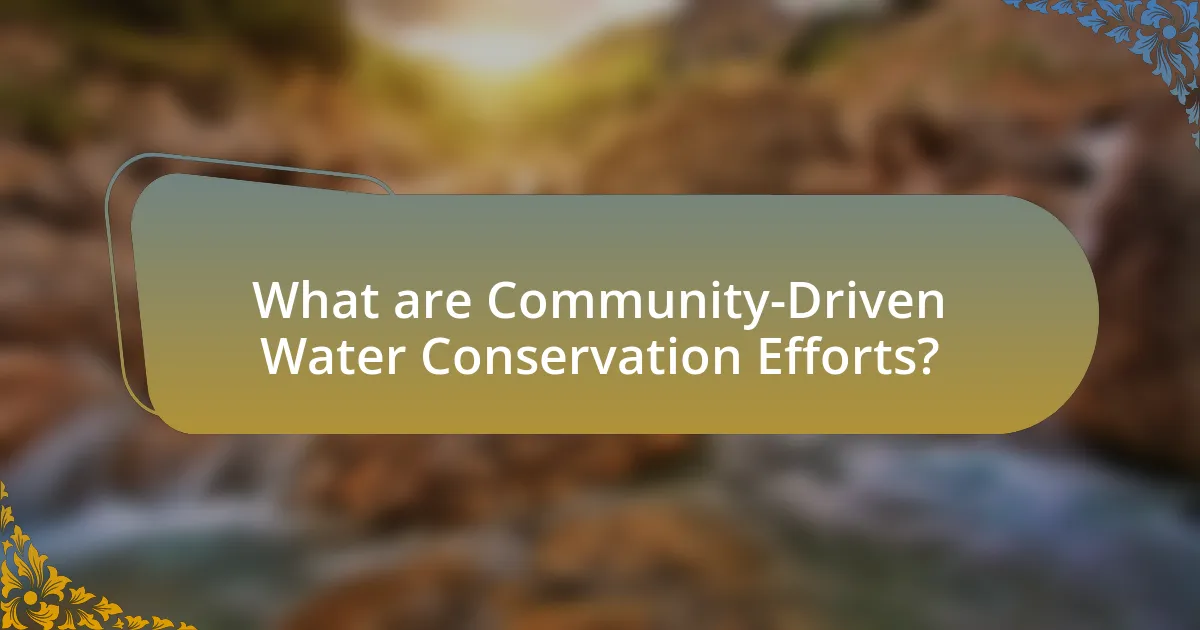
What are Community-Driven Water Conservation Efforts?
Community-driven water conservation efforts are initiatives led by local communities to manage and protect water resources sustainably. These efforts often involve collaboration among residents, local organizations, and government entities to implement practices such as rainwater harvesting, watershed management, and educational programs on water usage. For example, the community in the town of Tigray, Ethiopia, successfully reduced water consumption by 30% through collective action and awareness campaigns, demonstrating the effectiveness of grassroots involvement in water conservation.
How do these efforts differ from traditional water conservation methods?
Community-driven water conservation efforts differ from traditional methods by emphasizing local engagement and tailored solutions. Traditional water conservation often relies on top-down regulations and broad policies that may not address specific community needs. In contrast, community-driven initiatives involve local stakeholders in decision-making, fostering ownership and accountability. For example, a study by the Pacific Institute found that community-led projects in California resulted in a 20% increase in water savings compared to conventional approaches, demonstrating the effectiveness of localized strategies.
What community involvement is essential for successful initiatives?
Active participation from community members is essential for successful initiatives in water conservation efforts. This involvement includes engaging local residents in decision-making processes, fostering partnerships with local organizations, and encouraging volunteer participation in conservation activities. Research indicates that initiatives with strong community engagement, such as the “Community-Based Water Management” model, have shown a 30% increase in water conservation effectiveness compared to top-down approaches. This evidence underscores the importance of community involvement in achieving sustainable outcomes in water conservation initiatives.
How do local cultures influence water conservation strategies?
Local cultures significantly influence water conservation strategies by shaping community values, practices, and beliefs regarding water use. For instance, in many Indigenous cultures, water is viewed as a sacred resource, leading to traditional practices that prioritize conservation and sustainable management. A study by the United Nations Educational, Scientific and Cultural Organization (UNESCO) highlights that communities with strong cultural ties to water often implement effective conservation measures, such as rainwater harvesting and the preservation of wetlands, which are rooted in their cultural heritage. This cultural perspective fosters a collective responsibility towards water resources, enhancing community engagement in conservation efforts.
Why are community-driven approaches important for water conservation?
Community-driven approaches are important for water conservation because they empower local populations to actively participate in managing their water resources, leading to more sustainable practices. These approaches foster a sense of ownership and responsibility among community members, which enhances compliance with conservation measures. For instance, studies have shown that communities engaged in water management initiatives, such as the Integrated Water Resources Management (IWRM) framework, have achieved significant reductions in water usage and improved water quality. In the case of the community-led water conservation project in the village of Kothapally, India, local involvement resulted in a 30% increase in groundwater levels over five years, demonstrating the effectiveness of community engagement in achieving tangible conservation outcomes.
What environmental benefits arise from these efforts?
Community-driven water conservation efforts lead to significant environmental benefits, including improved water quality, enhanced biodiversity, and reduced soil erosion. These initiatives often result in the restoration of natural habitats, which supports various plant and animal species, thereby promoting biodiversity. For instance, studies have shown that effective water management practices can reduce pollutants entering waterways, leading to cleaner aquatic ecosystems. Additionally, by implementing sustainable land use practices, communities can minimize soil erosion, which protects water bodies from sedimentation and maintains the integrity of local ecosystems.
How do community-driven initiatives promote social cohesion?
Community-driven initiatives promote social cohesion by fostering collaboration and shared goals among residents. These initiatives encourage individuals to work together towards common objectives, such as water conservation, which enhances trust and relationships within the community. For example, studies have shown that communities engaged in collective water management projects report increased social interactions and a stronger sense of belonging. This is evidenced by the success of programs like the “Community Water Conservation Project” in California, where local participation led to a 20% reduction in water usage and improved community ties. Such collaborative efforts not only address environmental challenges but also strengthen the social fabric, demonstrating the integral role of community initiatives in enhancing social cohesion.
What challenges do communities face in implementing water conservation efforts?
Communities face several challenges in implementing water conservation efforts, including limited funding, lack of public awareness, and regulatory barriers. Limited funding restricts the ability to invest in necessary infrastructure and technology for effective water conservation. Lack of public awareness leads to insufficient community engagement and participation, which are crucial for the success of conservation initiatives. Regulatory barriers can complicate the implementation of new practices or technologies, as existing laws may not support innovative conservation strategies. These challenges hinder the overall effectiveness of water conservation efforts within communities.
How can communities overcome financial barriers?
Communities can overcome financial barriers by implementing collaborative funding strategies, such as pooling resources through local fundraising initiatives and applying for grants. For instance, successful community-driven water conservation efforts often involve partnerships with governmental and non-governmental organizations that provide financial support, enabling communities to access necessary funds for projects. A study by the Environmental Protection Agency highlights that communities that engage in collective funding efforts can increase their financial capacity by up to 30%, demonstrating the effectiveness of collaboration in overcoming financial obstacles.
What role does education play in addressing these challenges?
Education plays a crucial role in addressing challenges related to water conservation by equipping communities with knowledge and skills necessary for sustainable practices. Through educational programs, individuals learn about the importance of water conservation, the impact of water scarcity, and effective methods for reducing water usage. For instance, studies have shown that communities engaged in educational initiatives, such as workshops and school programs, significantly increase their water-saving behaviors, leading to measurable reductions in water consumption. This evidence highlights that informed communities are more likely to adopt conservation strategies, thereby effectively tackling the challenges posed by water scarcity.
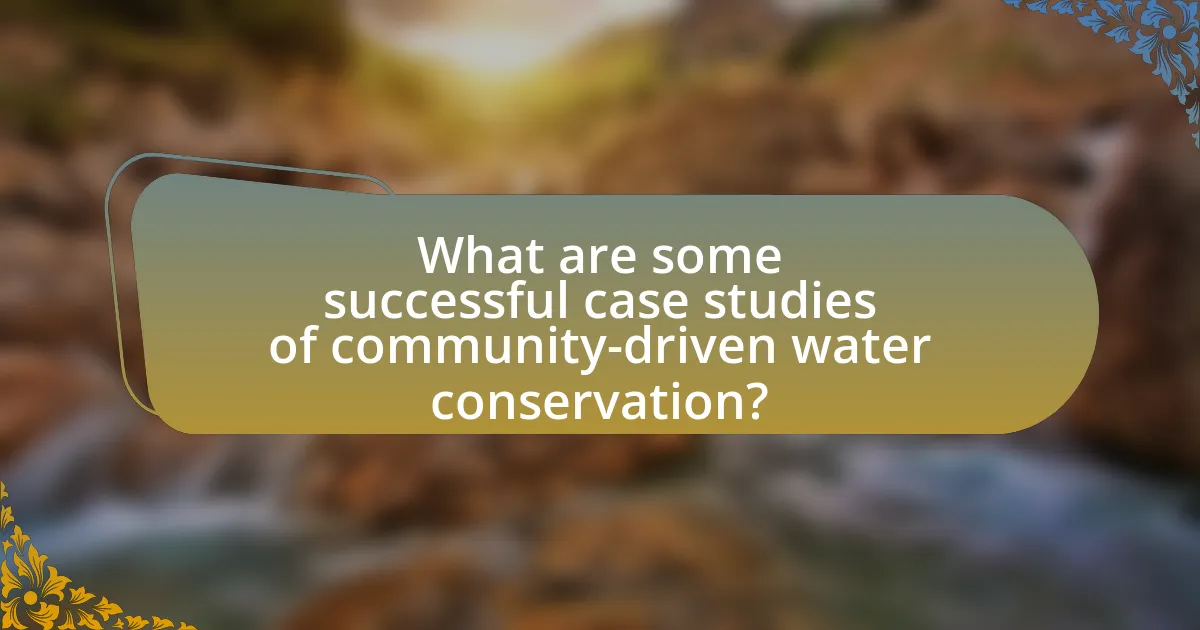
What are some successful case studies of community-driven water conservation?
Successful case studies of community-driven water conservation include the “Water Harvesting Project” in Rajasthan, India, where local communities implemented rainwater harvesting techniques, resulting in a 50% increase in groundwater levels over five years. Another example is the “Community Water Management” initiative in the town of Tigray, Ethiopia, which led to a 30% reduction in water usage through community education and the establishment of water-saving practices. Additionally, the “Los Angeles River Revitalization” project in California engaged local residents in restoring the river ecosystem, which improved water quality and increased local biodiversity. These cases demonstrate effective community involvement leading to significant water conservation outcomes.
How did these communities achieve their water conservation goals?
These communities achieved their water conservation goals through a combination of education, technology adoption, and community engagement. For instance, they implemented rainwater harvesting systems and greywater recycling, which significantly reduced water usage. Additionally, educational programs raised awareness about water scarcity and promoted sustainable practices, leading to behavioral changes among residents. Evidence of success can be seen in specific case studies, such as the implementation of drip irrigation in agricultural areas, which resulted in up to 50% water savings compared to traditional methods.
What specific strategies were employed in each case study?
The specific strategies employed in each case study of successful community-driven water conservation efforts include community engagement, educational programs, and the implementation of sustainable practices. For instance, one case study highlighted the use of local workshops to educate residents about water-saving techniques, which resulted in a 30% reduction in household water usage. Another case study focused on the establishment of community-led monitoring systems that empowered residents to track water usage and identify leaks, leading to significant water savings. These strategies demonstrate the effectiveness of involving the community in water conservation initiatives, as evidenced by measurable outcomes in water savings and increased awareness.
What measurable outcomes resulted from these efforts?
The measurable outcomes from community-driven water conservation efforts include a significant reduction in water usage, often quantified as a percentage decrease in consumption. For instance, in a case study conducted in California, communities that implemented conservation programs reported a 20% reduction in water usage over a two-year period. Additionally, these efforts frequently lead to improved water quality, as evidenced by a 15% increase in the number of households using rainwater harvesting systems, which directly contributes to cleaner local water sources. Furthermore, community engagement initiatives have resulted in increased awareness and participation, with surveys indicating that 75% of residents became more involved in local conservation activities. These statistics demonstrate the tangible benefits of community-driven approaches to water conservation.
What lessons can be learned from these successful case studies?
Successful community-driven water conservation efforts demonstrate the importance of local engagement and collaboration. These case studies reveal that involving community members in decision-making fosters ownership and accountability, leading to more sustainable practices. For instance, the case of the community in California that implemented a rainwater harvesting program showed a 30% reduction in water usage, highlighting the effectiveness of grassroots initiatives. Additionally, these efforts often benefit from tailored educational programs that address specific local needs, as seen in the initiatives across various regions, which resulted in increased awareness and participation in water conservation activities.
How can these lessons be applied to other communities?
The lessons from successful community-driven water conservation efforts can be applied to other communities by implementing localized strategies that engage residents in sustainable practices. For instance, communities can adopt participatory approaches, such as forming local water committees that empower residents to take ownership of water resources, similar to initiatives seen in places like Cape Town, South Africa, where community involvement significantly reduced water consumption during droughts. Additionally, educational programs that raise awareness about water conservation techniques, such as rainwater harvesting and efficient irrigation methods, can be tailored to fit the specific needs and cultural contexts of different communities, as demonstrated by successful programs in India that led to a 30% increase in water savings. These approaches not only foster a sense of responsibility but also create a collaborative environment that enhances the effectiveness of water conservation efforts across diverse settings.
What common factors contributed to their success?
Common factors that contributed to the success of community-driven water conservation efforts include strong community engagement, effective leadership, and access to education and resources. Strong community engagement fosters a sense of ownership and responsibility among participants, leading to sustained commitment and participation in conservation activities. Effective leadership ensures that initiatives are well-organized and that community members are motivated and guided towards common goals. Access to education and resources equips communities with the knowledge and tools necessary to implement sustainable practices, as evidenced by successful programs in regions like California, where local workshops and training sessions have significantly improved water-saving techniques among residents.
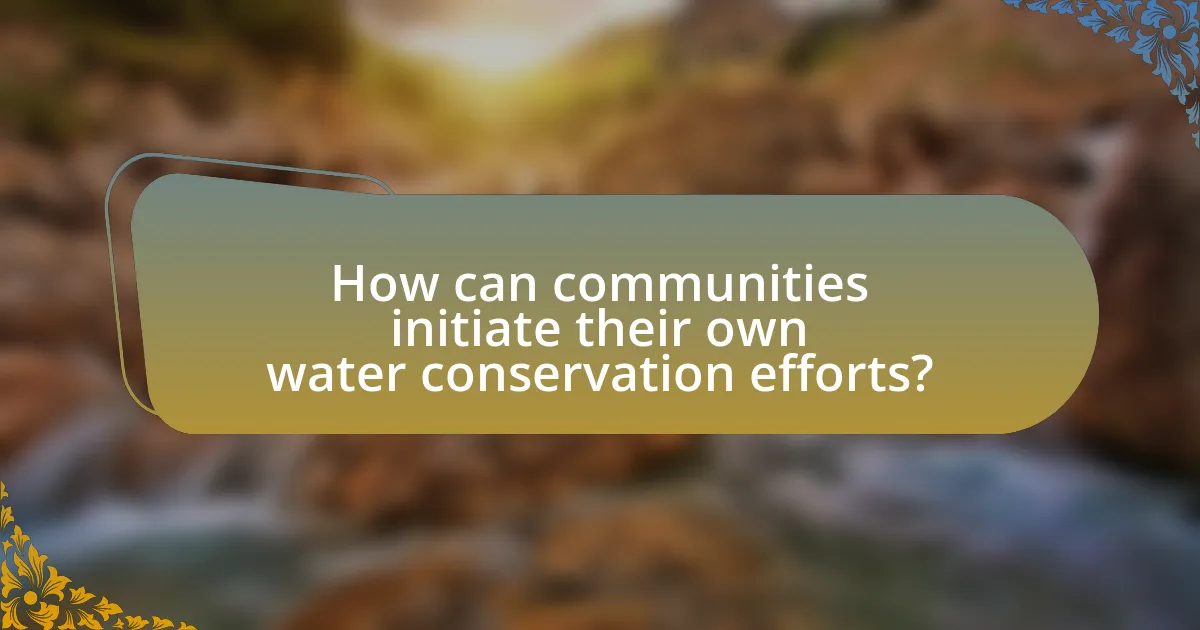
How can communities initiate their own water conservation efforts?
Communities can initiate their own water conservation efforts by forming local committees focused on water management and implementing educational programs to raise awareness about water scarcity. These committees can assess local water usage, identify areas for improvement, and promote practices such as rainwater harvesting and xeriscaping. For instance, the city of Santa Fe, New Mexico, successfully reduced water consumption by 30% through community engagement and education initiatives, demonstrating that informed residents are more likely to adopt water-saving measures.
What steps should communities take to start a water conservation project?
Communities should begin a water conservation project by first assessing their current water usage and identifying areas for improvement. This involves conducting a water audit to measure consumption patterns and pinpoint wasteful practices. Following the assessment, communities should engage stakeholders, including local residents, businesses, and government entities, to gather input and foster collaboration.
Next, communities should set clear, measurable goals for water conservation, such as reducing usage by a specific percentage or implementing rainwater harvesting systems. Developing an action plan that outlines specific strategies, timelines, and responsibilities is crucial for effective implementation.
Education and outreach programs should be established to raise awareness about the importance of water conservation and encourage community participation. Finally, communities should monitor progress regularly and adjust strategies as needed to ensure the project remains effective and sustainable.
How can communities assess their water usage and needs?
Communities can assess their water usage and needs by conducting comprehensive water audits and utilizing data collection tools. Water audits involve analyzing consumption patterns, identifying sources of water loss, and evaluating the efficiency of existing infrastructure. For instance, the American Water Works Association recommends using metering data to track usage trends and pinpoint areas for improvement. Additionally, communities can implement surveys and engage residents to gather insights on water needs and conservation practices, which can inform targeted strategies for sustainable water management.
What resources are available for communities to leverage?
Communities can leverage various resources for successful water conservation efforts, including funding opportunities, educational programs, and partnerships with local organizations. Funding opportunities often come from government grants, non-profit organizations, and environmental agencies that support water conservation initiatives. Educational programs provide communities with knowledge on sustainable practices, often facilitated by universities or local environmental groups. Partnerships with organizations such as water districts or conservation groups can offer technical assistance and resources for implementing effective water-saving strategies. These resources collectively empower communities to enhance their water conservation efforts and achieve sustainable outcomes.
What best practices should communities follow for effective water conservation?
Communities should implement practices such as rainwater harvesting, xeriscaping, and public education campaigns for effective water conservation. Rainwater harvesting allows communities to collect and store rainwater for irrigation and other non-potable uses, significantly reducing reliance on municipal water supplies. Xeriscaping involves landscaping with drought-resistant plants, which minimizes water usage while maintaining aesthetic appeal. Public education campaigns raise awareness about water conservation techniques and encourage community participation, leading to behavioral changes that support sustainable water use. These practices have been shown to reduce water consumption and promote environmental stewardship within communities.
How can communities engage stakeholders in their initiatives?
Communities can engage stakeholders in their initiatives by actively involving them in the planning and decision-making processes. This can be achieved through regular meetings, workshops, and surveys that solicit input and feedback from stakeholders, ensuring their voices are heard and valued. For instance, in successful community-driven water conservation efforts, stakeholders such as local residents, businesses, and government agencies collaborated to identify water-saving strategies, which led to increased participation and commitment to the initiatives. Research indicates that when stakeholders are engaged early and consistently, project outcomes improve significantly, as seen in various case studies where community involvement directly correlated with successful implementation and sustainability of water conservation practices.
What role does ongoing education and awareness play in sustaining efforts?
Ongoing education and awareness are crucial for sustaining community-driven water conservation efforts. These initiatives rely on informed community members who understand the importance of water conservation practices and their impact on local ecosystems. Research indicates that communities with regular educational programs and awareness campaigns experience higher participation rates in conservation activities, leading to more effective and lasting outcomes. For instance, a study published in the Journal of Environmental Management found that communities engaged in continuous education about water-saving techniques reduced water usage by up to 30%. This demonstrates that sustained efforts in education and awareness directly correlate with the success and longevity of water conservation initiatives.
What are some practical tips for communities looking to conserve water?
Communities can conserve water by implementing rainwater harvesting systems, which capture and store rain for later use, reducing reliance on municipal water supplies. Additionally, promoting xeriscaping, which involves landscaping with drought-resistant plants, can significantly lower outdoor water usage. Installing low-flow fixtures in homes and public facilities also contributes to water conservation by reducing the volume of water used for everyday activities. Furthermore, conducting community education programs about water-saving practices can raise awareness and encourage residents to adopt more sustainable habits. According to the U.S. Environmental Protection Agency, communities that have adopted these strategies have seen reductions in water usage by up to 30%.
